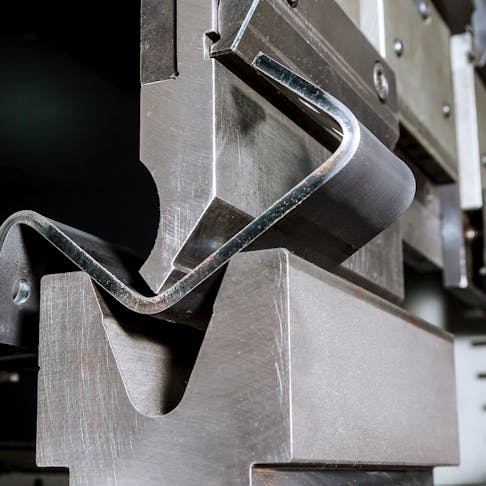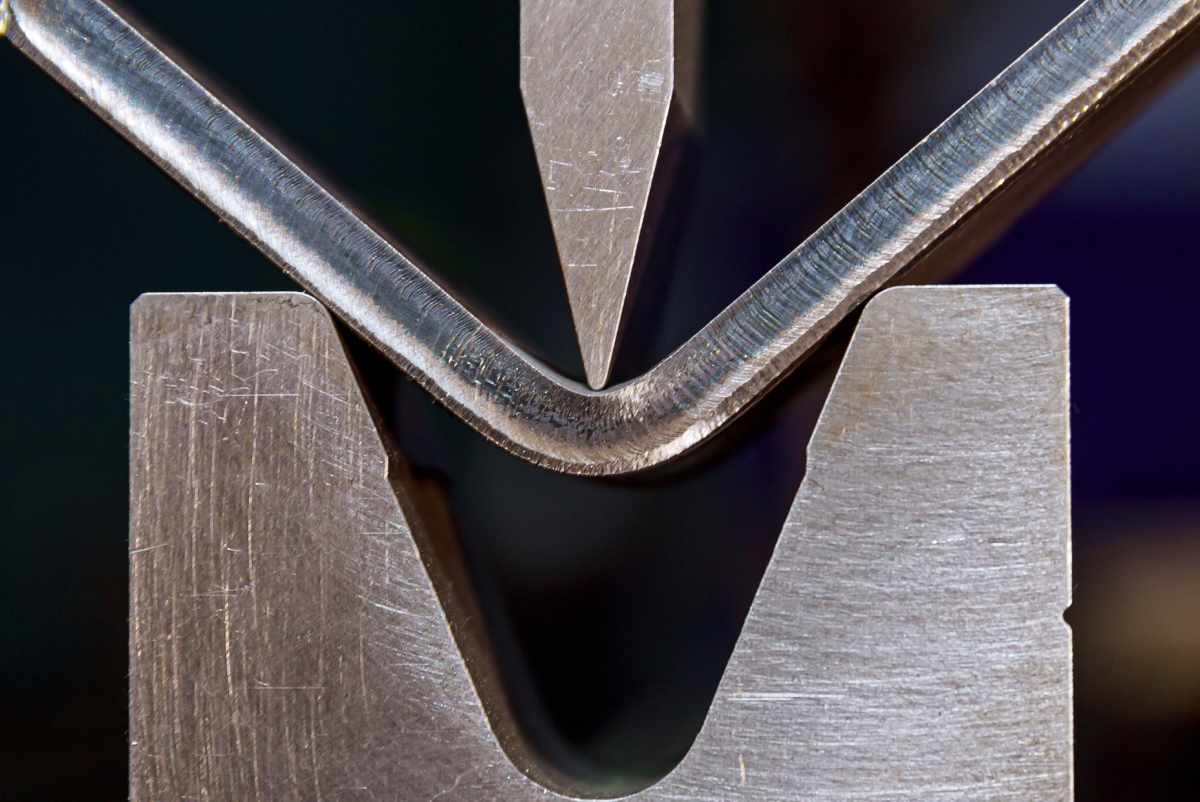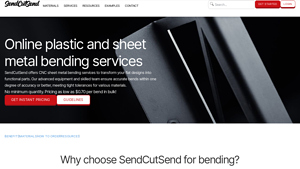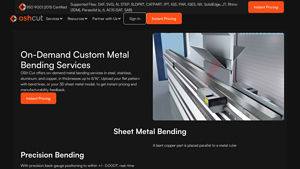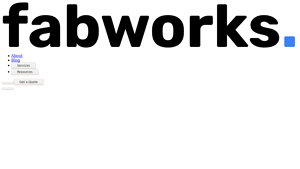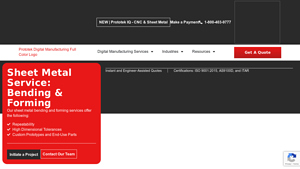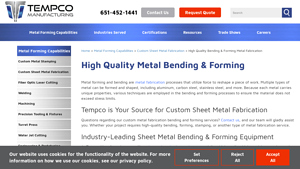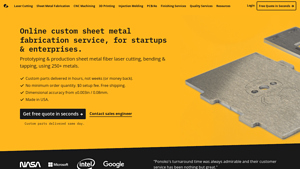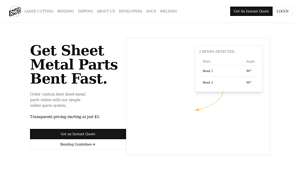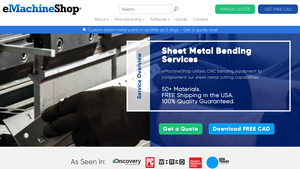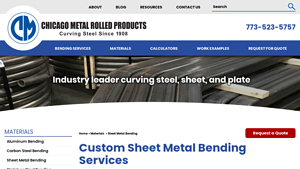Custom Sheet Metal Bending Guide: Type, Cost, Top List…
Introduction: Navigating the Global Market for custom sheet metal bending
Navigating the complexities of sourcing custom sheet metal bending services can be a daunting task for international B2B buyers, particularly those in rapidly developing markets across Africa, South America, the Middle East, and established economies in Europe like Germany and Saudi Arabia. The challenge lies not only in identifying qualified suppliers but also in understanding the nuances of materials, bending specifications, and the associated costs. This comprehensive guide aims to demystify the world of custom sheet metal bending by covering various aspects, including types of bending techniques, applications across different industries, and essential criteria for vetting suppliers.
By providing actionable insights into key considerations such as material specifications, tolerances, and production timelines, this guide empowers buyers to make informed purchasing decisions. It highlights the importance of clear communication with suppliers, ensuring that design requirements align with bending capabilities, ultimately reducing lead times and costs. Whether you’re a manufacturer in need of precision components or a distributor looking to expand your product offerings, this resource serves as a strategic tool for navigating the global market for custom sheet metal bending. Armed with this knowledge, B2B buyers can confidently engage with suppliers, optimize their sourcing processes, and enhance their competitive edge in an increasingly interconnected world.
Understanding custom sheet metal bending Types and Variations
| Type Name | Key Distinguishing Features | Primary B2B Applications | Brief Pros & Cons for Buyers |
|---|---|---|---|
| Air Bending | Utilizes a punch and die to create bends without full contact; allows for adjustments. | Automotive components, HVAC systems | Pros: Flexibility in design; fast setup. Cons: Less precision than other methods. |
| V-Bending | Involves a V-shaped die; ideal for creating sharp bends with consistent angles. | Electrical enclosures, brackets | Pros: High precision; suitable for thick materials. Cons: Limited to specific angles. |
| U-Bending | Employs a U-shaped die for bending; effective for creating rounded bends. | Structural components, frames | Pros: Reduces stress on material; good for complex shapes. Cons: Requires more material. |
| Rotary Bending | Uses a rotating tool to bend metal; offers a smooth, continuous bend. | Aerospace parts, intricate designs | Pros: Ideal for long bends; consistent radius. Cons: Higher initial setup costs. |
| Coining | Applies extreme pressure to create precise bends; often used for tight tolerances. | High-precision components, medical devices | Pros: Exceptional accuracy; excellent repeatability. Cons: Limited to lower production volumes. |
What Are the Key Characteristics of Air Bending in Custom Sheet Metal Bending?
Air bending is a versatile technique that employs a punch and die to create bends without fully contacting the material, allowing for adjustments during the process. This method is particularly useful in applications where flexibility is paramount, such as in automotive components and HVAC systems. Buyers should consider air bending for projects requiring rapid adjustments and lower setup times, although it may sacrifice some precision compared to other bending methods.
How Does V-Bending Differ from Other Bending Techniques?
V-bending utilizes a V-shaped die, making it ideal for producing sharp bends with consistent angles. This method is widely applied in creating electrical enclosures and brackets, where precision is critical. While V-bending provides high accuracy and is suitable for thicker materials, it is limited to specific angles, which may restrict design flexibility for some projects.
When to Use U-Bending for Custom Sheet Metal Fabrication?
U-bending employs a U-shaped die to achieve rounded bends, making it effective for structural components and frames. This technique is advantageous because it reduces stress on the material, allowing for the creation of complex shapes. However, it requires more material and may not be suitable for projects with tight budgets or strict material constraints.
What Are the Advantages of Rotary Bending in Custom Sheet Metal Bending?
Rotary bending employs a rotating tool to achieve smooth, continuous bends, making it ideal for aerospace parts and intricate designs. This method allows for long bends with a consistent radius, enhancing the aesthetic and functional quality of the final product. However, buyers should be aware of the higher initial setup costs associated with rotary bending, which may affect the overall project budget.
Why Choose Coining for High-Precision Sheet Metal Bending?
Coining is a high-pressure bending method that creates precise bends, making it suitable for high-precision components, including medical devices. This technique offers exceptional accuracy and repeatability, ensuring that parts meet stringent tolerances. However, coining is generally limited to lower production volumes, which may not be ideal for buyers looking for high-output solutions.
Key Industrial Applications of custom sheet metal bending
| Industry/Sector | Specific Application of custom sheet metal bending | Value/Benefit for the Business | Key Sourcing Considerations for this Application |
|---|---|---|---|
| Automotive | Manufacturing of chassis and brackets | Enhanced structural integrity and weight reduction | Precision in bend angles and tolerances; material selection |
| Construction | Fabrication of HVAC ductwork | Improved energy efficiency and cost savings | Compliance with local building codes; material durability |
| Aerospace | Production of aircraft components | Lightweight and high-strength materials | Strict adherence to aerospace standards; traceability of materials |
| Electronics | Enclosures for electronic devices | Protection against environmental factors | Customization options for size and design; rapid prototyping |
| Renewable Energy | Components for solar panel frames | Contribution to sustainability and energy efficiency | Corrosion resistance; adaptability to various environmental conditions |
How is Custom Sheet Metal Bending Used in the Automotive Sector?
In the automotive industry, custom sheet metal bending is crucial for manufacturing components like chassis and brackets. These parts require precise bending to ensure structural integrity while minimizing weight. For international buyers, especially in regions like Europe and the Middle East, sourcing components that meet stringent automotive standards is essential. This necessitates a focus on precision in bend angles and tolerances, as well as the selection of appropriate materials that can withstand the rigors of automotive applications.
What Role Does Custom Sheet Metal Bending Play in Construction?
In construction, custom sheet metal bending is predominantly used to fabricate HVAC ductwork. This application not only enhances energy efficiency but also leads to significant cost savings in heating and cooling systems. Buyers from Africa and South America should consider sourcing partners who can comply with local building codes and provide durable materials suitable for varying climates. Additionally, the ability to create custom designs that fit specific architectural requirements can greatly benefit construction projects.
Why is Custom Sheet Metal Bending Important in Aerospace Manufacturing?
The aerospace industry relies heavily on custom sheet metal bending for the production of lightweight yet strong aircraft components. These parts must adhere to strict aerospace standards, necessitating high-quality materials and precise manufacturing processes. International buyers, particularly from regions with advanced aerospace sectors like Germany, must prioritize suppliers who can ensure traceability of materials and compliance with rigorous industry regulations. This ensures both safety and performance in flight applications.
How Does Custom Sheet Metal Bending Benefit Electronics?
In the electronics sector, custom sheet metal bending is utilized for creating enclosures that protect sensitive components from environmental factors. These enclosures require precise dimensions and often need to accommodate specific design features. For buyers in the Middle East and Africa, sourcing partners that offer rapid prototyping and customization options can significantly enhance product development timelines. Ensuring that the materials used are suitable for electronic applications is also critical for long-term performance.
What Advantages Does Custom Sheet Metal Bending Offer in Renewable Energy?
Custom sheet metal bending is increasingly applied in the renewable energy sector, particularly for fabricating components like solar panel frames. These components must be lightweight yet robust to support sustainable energy solutions. Buyers in Europe and South America should seek suppliers that provide materials with corrosion resistance and adaptability to diverse environmental conditions. This not only contributes to sustainability but also ensures the longevity and efficiency of renewable energy systems.
3 Common User Pain Points for ‘custom sheet metal bending’ & Their Solutions
Scenario 1: Design Complexity and Misalignment Issues
The Problem: In the world of custom sheet metal bending, many B2B buyers encounter significant challenges when designing components with intricate geometries. Complex designs often lead to misalignment during the bending process, resulting in parts that do not meet specifications. This issue is especially prevalent when working with multiple bends and tight tolerances, where even slight deviations can render a component unusable. Buyers may find themselves stuck in a frustrating cycle of revisions, prolonging lead times and increasing costs as they attempt to resolve these design issues with their suppliers.
The Solution: To mitigate design complexity and alignment challenges, buyers should adopt a proactive approach by utilizing advanced design software and engaging in comprehensive pre-production planning. It’s crucial to leverage tools that can simulate the bending process, allowing designers to visualize how parts will behave during manufacturing. Furthermore, collaborating closely with suppliers to understand their bending capabilities, including k-factors and minimum bend radii, can help set realistic design expectations. By incorporating these specifications into the design phase, buyers can ensure that their parts are not only manufacturable but also align perfectly with their intended use. It’s also beneficial to request prototypes or small batch runs to test the fit and functionality before moving to full production.
Scenario 2: Material Selection and Performance Concerns
The Problem: Choosing the right material for custom sheet metal bending can be daunting for B2B buyers, particularly when considering factors like tensile strength, corrosion resistance, and overall performance under specific conditions. For instance, selecting a material that is too thin may lead to warping or failure during use, while opting for a thicker material could inflate costs unnecessarily. Many buyers struggle with balancing performance requirements against budget constraints, leading to a trial-and-error approach that can be both costly and time-consuming.
The Solution: To streamline material selection, buyers should engage in thorough research and consultation with material suppliers to understand the properties of various options. Creating a detailed material specification document that outlines the required performance criteria for each project can serve as a valuable reference. Additionally, buyers should consider using standardized material catalogs that provide data on bending specifications and performance characteristics. This information can guide them in making informed decisions while avoiding common pitfalls associated with improper material choices. Furthermore, establishing relationships with trusted suppliers who can provide samples and expert advice on material selection can enhance the decision-making process and ultimately lead to more successful outcomes.
Scenario 3: Cost Management and Unexpected Expenses
The Problem: Custom sheet metal bending projects often come with hidden costs that can surprise B2B buyers, impacting overall project budgets. These unexpected expenses may arise from issues such as tooling changes, design modifications, or delays in production. Buyers may find themselves facing inflated costs due to last-minute changes or the need for expedited processing, which can disrupt financial forecasting and strain budgets. The lack of transparency in pricing models further exacerbates this problem, making it difficult for buyers to predict total project costs accurately.
The Solution: To manage costs effectively, buyers should seek suppliers that offer transparent pricing structures and detailed quotes that break down all associated costs. It’s essential to have a clear understanding of the pricing model before committing to a project. Establishing a comprehensive project timeline and incorporating buffer time for potential revisions can also help mitigate the impact of unexpected expenses. Moreover, engaging in regular communication with suppliers throughout the project can ensure that any issues are addressed promptly, preventing them from escalating into costly problems. Finally, considering bulk orders or long-term contracts can lead to favorable pricing agreements, helping to stabilize costs over time. By taking these steps, buyers can gain better control over their budgets and minimize the risk of financial surprises.
Strategic Material Selection Guide for custom sheet metal bending
What Are the Key Properties of Common Materials Used in Custom Sheet Metal Bending?
When selecting materials for custom sheet metal bending, understanding the properties of various metals is crucial for ensuring optimal performance in the intended application. Below, we analyze four common materials: Mild Steel, Stainless Steel, Aluminum, and Copper.
Mild Steel: A Versatile Choice for Many Applications
Mild steel, known for its ductility and strength, is a popular choice in custom sheet metal bending. It has a good temperature and pressure rating, making it suitable for structural applications. However, it lacks corrosion resistance unless treated.
Pros: Mild steel is cost-effective and easy to work with, making it ideal for large production runs. Its excellent weldability and machinability enhance its manufacturing flexibility.
Cons: The primary drawback is its susceptibility to rust, which can limit its use in outdoor or humid environments. Additionally, it may not perform well under extreme temperatures.
Impact on Application: Mild steel is commonly used in automotive parts, construction, and general fabrication. Its compatibility with various coatings can mitigate corrosion issues.
Considerations for International Buyers: Compliance with standards like ASTM A36 is essential. Buyers from regions like Europe and the Middle East should be aware of local regulations regarding material specifications.
Stainless Steel: Durability and Corrosion Resistance
Stainless steel is renowned for its corrosion resistance and durability, making it suitable for applications exposed to harsh environments. It maintains its strength at elevated temperatures, which is beneficial for high-pressure applications.
Pros: The material’s resistance to corrosion and staining makes it ideal for food processing, medical equipment, and chemical handling. Its aesthetic appeal also makes it a favorite in architectural applications.
Cons: Stainless steel is generally more expensive than mild steel and can be more challenging to bend due to its hardness. This can lead to increased manufacturing complexity.
Impact on Application: Its compatibility with various media, including corrosive substances, makes it a preferred choice in industries such as pharmaceuticals and food processing.
Considerations for International Buyers: Compliance with standards such as ASTM A240 or EN 10088 is crucial. Buyers should also consider the specific grades of stainless steel that meet local regulations.
Aluminum: Lightweight and Corrosion-Resistant
Aluminum is lightweight and offers excellent corrosion resistance, making it an ideal material for applications where weight is a concern. It is also highly malleable, allowing for complex bends.
Pros: Aluminum’s lightweight nature reduces shipping costs and improves fuel efficiency in transportation applications. Its natural corrosion resistance means it often requires no additional coatings.
Cons: While aluminum is easy to bend, it can be more expensive than mild steel. Its lower strength compared to steel may limit its use in load-bearing applications.
Impact on Application: Commonly used in aerospace, automotive, and packaging, aluminum is suitable for applications requiring lightweight materials without compromising strength.
Considerations for International Buyers: Compliance with international standards such as ASTM B209 and EN 573 is important. Buyers should also consider local preferences for specific aluminum alloys.
Copper: Excellent Conductivity with Unique Properties
Copper is known for its excellent electrical and thermal conductivity, making it a preferred choice in electrical applications. It is also resistant to corrosion, particularly in non-oxidizing environments.
Pros: Its high conductivity makes it ideal for electrical components, while its antimicrobial properties are beneficial in plumbing applications. Copper is also aesthetically pleasing for architectural designs.
Cons: Copper is generally more expensive than other metals and can be more challenging to bend due to its hardness. Additionally, it may not be suitable for applications requiring high strength.
Impact on Application: Widely used in electrical wiring, plumbing, and decorative applications, copper is suitable for environments where conductivity is critical.
Considerations for International Buyers: Adherence to standards such as ASTM B370 is necessary. Buyers should also be aware of the fluctuating market prices for copper, which can affect project budgets.
Summary Table of Material Selection for Custom Sheet Metal Bending
| Material | Typical Use Case for custom sheet metal bending | Key Advantage | Key Disadvantage/Limitation | Relative Cost (Low/Med/High) |
|---|---|---|---|---|
| Mild Steel | Automotive parts, construction | Cost-effective and easy to work with | Susceptible to rust | Low |
| Stainless Steel | Food processing, medical equipment | Corrosion-resistant and durable | Higher cost and manufacturing complexity | High |
| Aluminum | Aerospace, automotive, packaging | Lightweight and corrosion-resistant | More expensive and lower strength | Medium |
| Copper | Electrical wiring, plumbing | Excellent conductivity | High cost and bending challenges | High |
This comprehensive analysis provides B2B buyers with actionable insights into material selection for custom sheet metal bending, ensuring informed decisions that align with their specific application needs and regional standards.
In-depth Look: Manufacturing Processes and Quality Assurance for custom sheet metal bending
What Are the Key Stages in the Manufacturing Process for Custom Sheet Metal Bending?
The manufacturing process for custom sheet metal bending typically involves several key stages: material preparation, forming, assembly, and finishing. Each stage plays a vital role in ensuring that the final product meets the required specifications and quality standards.
How Is Material Prepared for Custom Sheet Metal Bending?
Material preparation begins with the selection of the appropriate sheet metal type and thickness. Common materials include mild steel, stainless steel, aluminum, and copper, each with specific properties that affect bendability. The selected material is then cut into flat shapes using precision cutting methods like laser cutting or waterjet cutting. This stage may also involve applying protective coatings to prevent corrosion and damage during handling.
Once the material is cut, it is essential to verify the specifications against design requirements. This may involve using tools such as calipers and gauges to ensure that the dimensions and tolerances are correct before proceeding to the bending stage.
What Techniques Are Used in the Forming Stage of Custom Sheet Metal Bending?
Forming is the heart of the custom bending process, where the flat sheet metal is transformed into the desired shape. This is typically done using a press brake, which applies force to bend the metal along predetermined lines. Key techniques include:
-
Air Bending: This method allows for flexibility in bend angles and is suitable for various material thicknesses. It uses a punch and die to create a bend without the material touching the die’s bottom.
-
Bottom Bending: In this technique, the material is pressed against the die, creating a more accurate bend angle and a consistent bend radius.
-
Coining: This is a more precise method used for tighter tolerances, where the material is forced into the die to achieve exact dimensions.
Throughout the forming process, operators must continuously monitor parameters such as bend radius, K-factor, and material thickness to ensure that the final product meets design specifications.
How Is Assembly Conducted in Custom Sheet Metal Bending?
After the bending process, assembly may be necessary for parts that require multiple components to be joined together. Techniques such as welding, riveting, or using fasteners are commonly employed. The choice of assembly method depends on factors such as the strength requirements of the final product and any aesthetic considerations.
Effective assembly also requires meticulous attention to detail. Misalignment during assembly can lead to structural weaknesses and affect product performance. Hence, it is crucial to use jigs and fixtures that ensure precise alignment of components during the assembly process.
What Finishing Techniques Are Commonly Used After Custom Sheet Metal Bending?
Finishing is the final stage in the manufacturing process, where the product is treated to improve its appearance and resistance to environmental factors. Common finishing techniques include:
-
Powder Coating: This method involves applying a dry powder that is then cured under heat to create a durable finish. It is ideal for enhancing aesthetics and providing corrosion resistance.
-
Anodizing: Often used for aluminum parts, anodizing enhances corrosion resistance and allows for color finishes.
-
Plating: This involves applying a thin layer of metal to the surface to improve conductivity or corrosion resistance, often used for components that require electrical conductivity.
By applying these finishing techniques, manufacturers can ensure that the products not only meet functional requirements but also provide a high-quality appearance.
What Quality Assurance Practices Are Essential for Custom Sheet Metal Bending?
Quality assurance (QA) is a critical component of the manufacturing process, ensuring that products meet both international and industry-specific standards. For custom sheet metal bending, adhering to standards such as ISO 9001:2015 is essential. This standard focuses on maintaining a quality management system that enhances customer satisfaction and ensures continuous improvement.
What Are the Key Quality Control Checkpoints in the Manufacturing Process?
Quality control (QC) checkpoints throughout the manufacturing process include:
-
Incoming Quality Control (IQC): At this stage, raw materials are inspected for compliance with specifications. This includes checking material thickness, alloy composition, and surface defects.
-
In-Process Quality Control (IPQC): During the bending process, operators conduct regular checks to ensure that bend angles and dimensions are within specified tolerances. This may involve real-time monitoring and adjustments based on feedback from precision measurement tools.
-
Final Quality Control (FQC): Once manufacturing is complete, the final product undergoes a thorough inspection. This includes dimensional checks, visual inspections, and functional tests to ensure that the product meets all design and performance specifications.
How Can B2B Buyers Verify Supplier Quality Control?
For international B2B buyers, particularly from regions such as Africa, South America, the Middle East, and Europe, verifying a supplier’s quality control practices is essential. Here are several methods:
-
Supplier Audits: Conducting on-site audits allows buyers to assess the supplier’s manufacturing processes, equipment, and quality management systems directly. This firsthand evaluation helps ensure that suppliers maintain high standards.
-
Quality Reports: Requesting detailed quality reports from suppliers can provide insights into their QC processes, including metrics on defect rates and compliance with industry standards.
-
Third-Party Inspections: Engaging independent third-party inspection services can offer an unbiased evaluation of the supplier’s quality practices. This is particularly important for buyers who require additional assurance regarding the quality of their products.
What Nuances Should International B2B Buyers Consider Regarding Quality Control?
International B2B buyers must be aware of the nuances in quality control that can vary significantly by region. Different countries may have varying regulations, industry standards, and cultural attitudes towards quality assurance. For instance, European standards for manufacturing might be stricter compared to those in other regions. Buyers should familiarize themselves with local regulations and quality standards to ensure compliance and avoid potential issues.
Additionally, understanding the supplier’s capabilities in meeting international standards, such as CE marking for products sold in the European market or API standards for oil and gas applications, can significantly affect purchasing decisions.
In conclusion, a comprehensive understanding of the manufacturing processes and quality assurance practices for custom sheet metal bending is essential for B2B buyers. By focusing on each stage of the manufacturing process and implementing robust quality control measures, suppliers can deliver high-quality products that meet the diverse needs of international markets.
Practical Sourcing Guide: A Step-by-Step Checklist for ‘custom sheet metal bending’
Introduction
This guide provides a practical step-by-step checklist for B2B buyers seeking to procure custom sheet metal bending services. It aims to streamline the sourcing process by outlining critical considerations and actions to ensure successful procurement, from defining specifications to evaluating suppliers.
Step 1: Define Your Technical Specifications
Clearly outlining your technical specifications is vital for ensuring that your custom sheet metal bending meets your project requirements. Focus on key parameters such as material type, thickness, bend radius, and tolerances. This clarity helps suppliers understand your needs, reducing the risk of errors and miscommunication later in the process.
- Material Requirements: Specify the type of metal (e.g., steel, aluminum) and any relevant standards (e.g., ASTM).
- Bend Details: Indicate the required bend radius and angle to avoid potential issues during manufacturing.
Step 2: Research Potential Suppliers
Conduct thorough research to identify suppliers who specialize in custom sheet metal bending. Look for companies with a proven track record in your industry or region. This step is crucial as it sets the foundation for a reliable partnership.
- Supplier Reviews: Check online reviews and testimonials to gauge customer satisfaction.
- Industry Experience: Consider suppliers with experience in similar projects or materials.
Step 3: Evaluate Supplier Certifications
Before making a commitment, verify the certifications of potential suppliers. ISO certifications, for example, indicate adherence to quality management standards, which can significantly impact the quality of your parts.
- ISO 9001 Certification: Ensures consistent quality and customer satisfaction.
- Other Relevant Certifications: Look for certifications that pertain to specific materials or industries, such as AS9100 for aerospace components.
Step 4: Request and Review Quotes
Once you have shortlisted suppliers, request detailed quotes for your project. A comprehensive quote should outline pricing, lead times, and any additional services (e.g., finishing options) available.
- Price Breakdown: Ensure the quote includes a breakdown of costs for materials, labor, and shipping.
- Lead Times: Confirm the expected production and delivery timelines to align with your project schedule.
Step 5: Assess Manufacturing Capabilities
Understanding a supplier’s manufacturing capabilities is essential to ensure they can meet your specifications. Evaluate their equipment, technology, and production processes to determine if they can handle your project requirements efficiently.
- Equipment Quality: Inquire about the types of machines used for bending and their precision levels.
- Production Capacity: Ensure the supplier can meet your volume needs, whether it’s a one-off prototype or a large batch.
Step 6: Verify Communication and Support
Effective communication is crucial throughout the sourcing process. Assess how responsive and supportive the supplier is during your interactions, as this will be indicative of the collaboration experience.
- Response Times: Evaluate how quickly they address inquiries and provide information.
- Technical Support: Ensure they offer design assistance and can provide insights on manufacturability.
Step 7: Finalize and Place Your Order
After evaluating potential suppliers and securing the best fit for your needs, finalize your order. Ensure all specifications are clearly documented in the purchase agreement to prevent misunderstandings.
- Documentation: Include all technical specifications, delivery dates, and payment terms.
- Follow-Up: Maintain regular communication to track the order progress and address any potential issues promptly.
By following this checklist, B2B buyers can navigate the complexities of sourcing custom sheet metal bending services with confidence, ensuring quality and efficiency in their procurement processes.
Comprehensive Cost and Pricing Analysis for custom sheet metal bending Sourcing
What Are the Key Cost Components in Custom Sheet Metal Bending?
When evaluating the costs associated with custom sheet metal bending, several critical components come into play:
-
Materials: The choice of material significantly impacts pricing. Common options include aluminum, stainless steel, and carbon steel, each with varying costs based on thickness, type, and market demand. For instance, 5052 aluminum tends to be pricier than mild steel due to its superior properties.
-
Labor: Labor costs are influenced by the complexity of the bending process and the skill level required. Skilled operators are essential for precision bending, particularly for intricate designs, which can elevate labor expenses.
-
Manufacturing Overhead: This encompasses the indirect costs associated with production, such as utilities, equipment maintenance, and facilities. Efficient manufacturing processes can help mitigate these costs.
-
Tooling: The initial investment in tools and dies is a substantial cost, especially for custom or specialized parts. Tooling costs can be amortized over larger production runs, making it crucial to consider the volume of parts being ordered.
-
Quality Control (QC): Maintaining high standards of quality involves inspections and testing, which add to the overall cost. Certifications (like ISO 9001) can also influence pricing, as they ensure compliance with industry standards.
-
Logistics: Shipping costs can vary widely based on distance, weight, and shipping methods. For international buyers, understanding Incoterms is vital to avoid unexpected charges.
-
Margin: Suppliers typically add a margin to cover their risks and ensure profitability. This margin can vary based on market conditions and the supplier’s business model.
What Influences Pricing in Custom Sheet Metal Bending?
Several factors can influence the pricing of custom sheet metal bending services:
-
Volume and Minimum Order Quantity (MOQ): Higher volumes often lead to lower per-unit costs due to economies of scale. Suppliers may offer tiered pricing, where the cost per part decreases with increased quantities.
-
Specifications and Customization: Unique specifications or complex designs require more time and resources, which can drive up costs. Providing detailed designs upfront can help suppliers give more accurate quotes.
-
Material Selection: The type and thickness of material directly impact pricing. High-strength or specialized materials will typically incur higher costs.
-
Quality and Certifications: Parts that require specific certifications or meet stringent quality standards will generally be more expensive. Buyers should assess whether these certifications are necessary for their applications.
-
Supplier Factors: The supplier’s location, reputation, and production capabilities can affect pricing. Established suppliers with advanced technology might charge more but offer better precision and reliability.
-
Incoterms: Understanding the terms of shipment can prevent unexpected costs. Different Incoterms dictate who bears the cost and risk at various stages of the shipping process.
What Are the Best Negotiation and Cost-Efficiency Tips for B2B Buyers?
To maximize value in sourcing custom sheet metal bending, international buyers should consider the following strategies:
-
Negotiate Volume Discounts: Engage suppliers in discussions about bulk orders. Establishing a long-term relationship can often lead to better pricing and terms.
-
Evaluate Total Cost of Ownership (TCO): Look beyond initial costs and consider factors like durability, maintenance, and potential waste. A higher upfront cost may lead to lower overall expenses if the product lasts longer.
-
Request Detailed Quotes: Ensure quotes break down costs clearly, including materials, labor, and logistics. This transparency can aid in comparing different suppliers.
-
Be Aware of Pricing Nuances: International buyers must consider currency fluctuations, tariffs, and import duties, which can significantly affect the final cost.
-
Utilize Technology: Many suppliers offer instant pricing tools that allow buyers to configure their orders and see real-time cost implications based on material and design specifications.
Conclusion
Understanding the intricate cost structure and price influencers of custom sheet metal bending is essential for international B2B buyers. By strategically negotiating, evaluating total costs, and leveraging technology, buyers can enhance their sourcing efficiency while ensuring quality and compliance with their specifications. Always remember that pricing can vary widely based on the factors mentioned, so it’s prudent to request indicative prices from multiple suppliers before making decisions.
Alternatives Analysis: Comparing custom sheet metal bending With Other Solutions
Introduction
In the realm of manufacturing, particularly in industries requiring precision and customization, the choice of fabrication methods is critical. Custom sheet metal bending is a widely adopted solution for creating complex shapes and components. However, it is essential for B2B buyers to explore alternative methods that may offer distinct advantages depending on specific project requirements. This analysis compares custom sheet metal bending with two viable alternatives: metal stamping and 3D printing, providing insights into their respective performance, cost, and suitability for various applications.
Comparison Table
| Comparison Aspect | Custom Sheet Metal Bending | Metal Stamping | 3D Printing |
|---|---|---|---|
| Performance | High precision; complex geometries possible | High-speed production; consistent quality | Versatile shapes; less precision on larger scales |
| Cost | Moderate initial investment; cost-effective for small to medium runs | Lower cost per unit for high volumes; high setup costs | High material costs; economical for prototyping |
| Ease of Implementation | Requires detailed design files; setup can be time-consuming | Quick once tooling is established; limited design flexibility | Simple design process; no tooling required |
| Maintenance | Moderate; equipment needs regular calibration | High; requires maintenance of dies and presses | Low; minimal maintenance needed for printers |
| Best Use Case | Custom parts in low to medium volumes | High-volume production of uniform parts | Prototyping and low-volume production of complex designs |
Detailed Breakdown
Metal Stamping
Metal stamping is a manufacturing process that uses dies to shape metal sheets into desired forms. This method excels in high-volume production, making it ideal for industries that require large quantities of uniform parts, such as automotive and appliance manufacturing. The primary advantage of metal stamping lies in its speed and efficiency, allowing for rapid production cycles. However, the initial setup costs for tooling can be significant, making it less cost-effective for small runs. Additionally, metal stamping has limitations in terms of design flexibility, as complex geometries may not be achievable without extensive modifications to the tooling.
3D Printing
3D printing, or additive manufacturing, is a versatile approach that allows for the creation of complex geometries directly from digital models. This method is particularly advantageous for prototyping and small-batch production, as it eliminates the need for expensive tooling and setup. 3D printing can produce intricate designs that may be difficult or impossible to achieve with traditional methods. However, it often comes with higher material costs and may lack the precision required for certain applications, especially in larger parts. Overall, 3D printing is best suited for projects where design complexity is prioritized over production speed and cost.
Conclusion
Choosing the right fabrication method is crucial for B2B buyers looking to optimize their manufacturing processes. Custom sheet metal bending offers high precision and flexibility for custom designs, making it ideal for low to medium volume production. In contrast, metal stamping is best for high-volume, uniform parts, while 3D printing excels in prototyping and complex shapes without the need for tooling. Buyers should carefully assess their project requirements, including volume, design complexity, and budget, to select the most suitable solution for their specific needs.
Essential Technical Properties and Trade Terminology for custom sheet metal bending
What Are the Key Technical Properties in Custom Sheet Metal Bending?
Understanding the essential technical properties of custom sheet metal bending is crucial for B2B buyers looking to optimize their designs and manufacturing processes. Here are some critical specifications:
-
Material Grade
The material grade refers to the type of metal used for bending, such as stainless steel, aluminum, or mild steel. Each grade has unique properties, including tensile strength, corrosion resistance, and workability. Choosing the right material grade is vital for ensuring the finished product meets performance requirements, especially in demanding environments like automotive or aerospace applications. -
Bend Radius
The bend radius is the minimum radius a bend can achieve without compromising the integrity of the material. It varies depending on the material type and thickness. Understanding the bend radius is crucial for preventing cracking or deformation during the bending process, which can lead to costly rework or production delays. -
K-Factor
The K-factor is a critical value that represents the ratio of the material’s neutral axis to its thickness. This factor is essential for accurately calculating the flat length of the sheet metal before bending. A precise K-factor ensures that the final dimensions of the part are accurate, which is particularly important for complex assemblies or precision applications. -
Tolerance
Tolerance refers to the allowable deviation from specified dimensions. In custom sheet metal bending, common tolerances can range from ±0.005 inches to ±0.010 inches, depending on the complexity and application of the part. Understanding and specifying the required tolerances is crucial for ensuring that parts fit correctly in assemblies, which can affect overall product quality and functionality. -
Minimum Flange Length
This specification defines the shortest length of the flange that can be bent without affecting the structural integrity of the part. Adequate flange length is essential for maintaining strength and stability, especially in load-bearing applications. Buyers must communicate their design needs clearly to ensure manufacturability.
Which Trade Terms Are Essential for Custom Sheet Metal Bending?
Familiarity with industry jargon can streamline communication and negotiation processes. Here are some key trade terms:
-
OEM (Original Equipment Manufacturer)
An OEM is a company that produces parts or equipment that may be marketed by another manufacturer. Understanding the role of OEMs is important for buyers who may rely on third-party manufacturers for custom sheet metal components. -
MOQ (Minimum Order Quantity)
MOQ refers to the smallest quantity of a product that a supplier is willing to sell. Knowing the MOQ is essential for B2B buyers to assess their purchasing strategy and manage inventory effectively. -
RFQ (Request for Quotation)
An RFQ is a document sent to suppliers to solicit pricing and terms for specific products or services. Submitting an RFQ is a common practice in the B2B space and helps buyers compare options and negotiate better deals. -
Incoterms (International Commercial Terms)
Incoterms are a set of predefined commercial terms published by the International Chamber of Commerce (ICC). They define the responsibilities of buyers and sellers regarding shipping, insurance, and tariffs. Understanding Incoterms is crucial for international transactions, helping to clarify costs and responsibilities. -
Lead Time
Lead time refers to the period between placing an order and receiving the product. In custom sheet metal bending, lead times can vary significantly based on material availability and production complexity. Buyers must factor in lead times to meet project deadlines and avoid disruptions. -
Post-Processing
This term encompasses additional operations performed after the primary manufacturing process, such as finishing, coating, or assembly. Understanding post-processing options allows buyers to specify their requirements for product aesthetics and performance.
By grasping these technical properties and trade terms, B2B buyers can make informed decisions, streamline their procurement processes, and enhance their product quality in custom sheet metal bending projects.
Navigating Market Dynamics and Sourcing Trends in the custom sheet metal bending Sector
What Are the Current Market Dynamics and Key Trends in Custom Sheet Metal Bending?
The custom sheet metal bending sector is experiencing robust growth, driven by several global factors. Increased demand for lightweight and durable materials in industries such as automotive, aerospace, and construction is propelling innovation in metal bending technologies. B2B buyers in regions like Africa, South America, the Middle East, and Europe are particularly focused on sourcing high-quality, cost-effective solutions. Emerging technologies such as automated bending machines and advanced CAD/CAM software are streamlining the design and manufacturing processes, allowing for quicker turnaround times and enhanced accuracy.
Moreover, the trend towards just-in-time manufacturing and lean production is influencing sourcing strategies. Buyers are seeking suppliers that can provide instant pricing and rapid prototyping services, minimizing lead times while maintaining flexibility in order quantities. The rise of e-commerce platforms tailored for industrial buyers is reshaping how transactions are conducted, fostering greater transparency and accessibility. International buyers must also navigate varying regulatory environments and trade tariffs, particularly in Europe and the Middle East, which can affect sourcing decisions and cost structures.
How Is Sustainability and Ethical Sourcing Influencing the Custom Sheet Metal Bending Industry?
Sustainability is becoming a pivotal concern in the custom sheet metal bending sector. As global awareness of environmental issues rises, B2B buyers are increasingly prioritizing suppliers with sustainable practices. This includes the use of recycled materials and processes that minimize waste and energy consumption. Certifications such as ISO 14001 for environmental management systems are becoming essential for suppliers to demonstrate their commitment to sustainability.
Ethical sourcing is equally important, with buyers looking for transparency in their supply chains. This encompasses not only the environmental impact but also the social implications of sourcing decisions. Suppliers that adhere to fair labor practices and ensure safe working conditions are favored by conscientious buyers. The incorporation of ‘green’ materials, such as those with low carbon footprints or certifications like LEED (Leadership in Energy and Environmental Design), is becoming a key factor in purchasing decisions, enhancing brand reputation and compliance with regional regulations.
What Is the Brief Evolution of Custom Sheet Metal Bending?
The custom sheet metal bending industry has evolved significantly over the past few decades. Initially dominated by manual labor and rudimentary machinery, advancements in technology have transformed the landscape. The introduction of CNC (Computer Numerical Control) machines has vastly improved precision and efficiency, allowing for complex designs that were previously unattainable.
In recent years, the integration of Industry 4.0 principles—such as IoT (Internet of Things) and AI (Artificial Intelligence)—has further revolutionized the sector. These technologies facilitate real-time monitoring and predictive maintenance, reducing downtime and enhancing productivity. As a result, the industry is better equipped to meet the demands of modern manufacturing while adhering to stringent quality standards and sustainability goals. This evolution reflects a broader trend towards digitalization and automation in manufacturing, positioning the custom sheet metal bending sector for continued growth in the global market.
Frequently Asked Questions (FAQs) for B2B Buyers of custom sheet metal bending
1. How do I solve the issue of design clearance in custom sheet metal bending?
To prevent collisions in designs with perpendicular flanges, ensure adequate clearance between the flanges. Incorporate features such as break-off tabs or additional spacing in your design files. Collaborate with your supplier to understand their specific bending parameters, such as minimum flange lengths and bend radii, which can significantly affect manufacturability. Utilizing simulation tools or software that your supplier provides can also help identify potential issues before production, minimizing delays and costs.
2. What is the best material for custom sheet metal bending?
The choice of material depends on the application and desired properties. Common options include aluminum for lightweight applications, stainless steel for corrosion resistance, and mild steel for general use. Each material has unique bending characteristics, such as the required bend radius and K-factor. It’s crucial to consult with your supplier’s material catalog to understand these specifications and ensure they align with your project requirements.
3. How can I ensure quality assurance in custom sheet metal bending?
Quality assurance can be achieved by partnering with ISO-certified manufacturers who adhere to strict quality standards. Request detailed quality control processes from your supplier, including inspection methods, tolerances, and certifications. Implementing a clear communication channel for feedback during production helps address potential issues early. Additionally, consider using third-party inspections for critical components to ensure they meet your specifications before shipment.
4. What are the typical lead times for custom sheet metal bending orders?
Lead times can vary based on the complexity of the design, material availability, and the supplier’s workload. Generally, standard orders may take between 2 to 4 days for production, while more complex projects could require additional time for setup and processing. Discuss your timeline with potential suppliers upfront and consider expedited services if you have urgent requirements. Always factor in shipping time to your destination when planning your project schedule.
5. How do I vet a supplier for custom sheet metal bending services?
Begin by researching potential suppliers’ certifications, experience, and customer reviews. Request references from previous clients, particularly those in your industry. Evaluate their manufacturing capabilities, including equipment and technology, to ensure they can meet your specific needs. Additionally, inquire about their communication practices and responsiveness, as these factors are crucial for a successful partnership. Engaging in a trial order can also provide insights into their reliability and quality.
6. What are the minimum order quantities (MOQ) for custom sheet metal bending?
Minimum order quantities vary widely among suppliers and can range from one-off prototypes to bulk orders in the thousands. Some manufacturers may offer no MOQ, while others might require a minimum to justify production costs. Discuss your needs with potential suppliers to find one that can accommodate your order size. Consider the implications of MOQ on your inventory management and cash flow, especially for international shipments.
7. What payment terms should I expect when sourcing custom sheet metal bending?
Payment terms can differ based on the supplier’s policies and your relationship with them. Common options include upfront payment, partial payment upon order confirmation, and balance upon delivery. For international transactions, be aware of currency exchange rates and transaction fees. Establish clear payment terms in your contract to avoid misunderstandings and ensure a smooth purchasing process. Some suppliers may also offer financing options for larger orders.
8. How can logistics impact my custom sheet metal bending project?
Logistics play a critical role in the overall success of your project. Consider factors such as shipping methods, delivery times, and customs regulations when importing custom parts. Collaborate with your supplier to determine the best shipping options that align with your deadlines. It’s also advisable to plan for potential delays caused by customs clearance or transportation issues, especially for international shipments. Establishing a reliable logistics partner can enhance efficiency and reduce risks in your supply chain.
Important Disclaimer & Terms of Use
⚠️ Important Disclaimer
The information provided in this guide, including content regarding manufacturers, technical specifications, and market analysis, is for informational and educational purposes only. It does not constitute professional procurement advice, financial advice, or legal advice.
While we have made every effort to ensure the accuracy and timeliness of the information, we are not responsible for any errors, omissions, or outdated information. Market conditions, company details, and technical standards are subject to change.
B2B buyers must conduct their own independent and thorough due diligence before making any purchasing decisions. This includes contacting suppliers directly, verifying certifications, requesting samples, and seeking professional consultation. The risk of relying on any information in this guide is borne solely by the reader.
Top 9 Custom Sheet Metal Bending Manufacturers & Suppliers List
1. SendCutSend – CNC Sheet Metal Bending Services
Domain: sendcutsend.com
Registered: 2015 (10 years)
Introduction: SendCutSend offers CNC sheet metal bending services to transform flat designs into functional parts. Key features include:
– Tolerances of +/- 1 degree or better
– No minimum quantity required
– Pricing as low as $0.70 per bend in bulk
– Capable of bending 9 metals and 1 plastic
– Bending thicknesses up to .250″
– Flexible sizing from .375″ x 1.5″ up to 44″ x 30″
– Production time of +1-2 d…
2. OSH Cut – On-Demand Custom Metal Bending Services
Domain: oshcut.com
Registered: 2018 (7 years)
Introduction: On-Demand Custom Metal Bending Services offered by OSH Cut include bending in steel, stainless steel, aluminum, and copper, with thicknesses up to 5/16″. The service provides instant pricing and manufacturability feedback by allowing users to upload flat patterns with bend lines or 3D sheet metal models. Precision bending is achieved with back-gauge positioning within +/- 0.0001″, real-time materi…
3. Fabworks – Precision Sheet Metal Bending Service
Domain: fabworks.com
Registered: 2000 (25 years)
Introduction: Sheet Metal Bending Service at Fabworks offers precision bending using advanced CNC technology. Key features include:
– Upload 3D STEP files for automatic bending configuration.
– No minimum quantity required for orders.
– Materials available: aluminum, steel, stainless steel.
– Bending capabilities: 1-135 degree bends with +/- 1 degree angle tolerance and +/- .015″ length tolerance.
– Quick turna…
4. Prototek – Sheet Metal Bending and Forming Services
Domain: prototek.com
Registered: 1996 (29 years)
Introduction: Sheet Metal Bending and Forming Services at Prototek include:
– Repeatability and High Dimensional Tolerances
– Custom Prototypes and End-Use Parts
– Certifications: ISO 9001:2015, AS9100D, ITAR
– In-House Services: 3D Printing, CNC Machining, Urethane Casting, Sheet Metal Fabrication
– Lead Time: 1 – 15 Days
– Max Dimensions: Press Brake Tonnage: 90 tons, Maximum Sheet Metal Bend Length: 10 ft
– …
5. Tempco – Custom Metal Bending & Forming
Domain: tempcomfg.com
Registered: 1996 (29 years)
Introduction: Custom Metal Bending & Forming services include high-quality metal fabrication processes that reshape materials using force. Metals that can be formed include aluminum, carbon steel, stainless steel, and more. Tempco utilizes advanced production equipment, including a 14 ft. press brake for heavy-duty jobs and precision stamping equipment with capacities from 10 to 440 tons. Value-added services o…
6. Ponoko – Custom Sheet Metal Fabrication
Domain: ponoko.com
Registered: 2006 (19 years)
Introduction: Custom online sheet metal fabrication service for startups & enterprises. Services include laser cutting, bending, tapping, and finishing. Capable of using 250+ metals. Key features: same-day delivery, no minimum order quantity, $0 setup fee, free shipping, dimensional accuracy of ±0.003in / 0.08mm, made in USA. Maximum part size: 3000 x 1500mm, maximum thickness: 25.4mm. Minimum lead time for San…
7. RMFG – Custom Sheet Metal Bending Services
Domain: rmfg.com
Registered: 2000 (25 years)
Introduction: Sheet Metal Bending Service – Custom bent sheet metal parts available online. Fast turnaround with most parts shipping within 3 days. Precision manufacturing using CNC press brake with ±1° bend angle tolerance. Volume pricing: $4.00 per bend for 1+ parts, $3.00 for 2+ parts, $2.50 for 10+ parts, $2.00 for 50+ parts, and $1.00 for 100+ parts. Standard tolerances: ±0.015″ for linear dimensions and ±…
8. eMachineShop – CNC Bending Services
Domain: emachineshop.com
Registered: 1999 (26 years)
Introduction: eMachineShop offers CNC bending services for custom sheet metal parts, utilizing advanced CNC bending equipment alongside their sheet metal cutting capabilities. Key features include:
– Custom sheet metal parts produced in as little as 3 days.
– Over 50 materials available for bending, including aluminum, stainless steel, brass, titanium, and more.
– Maximum thickness for bending is up to 0.25 inc…
9. CMRP – Custom Sheet Metal Bending Services
Domain: cmrp.com
Registered: 1996 (29 years)
Introduction: Custom sheet metal bending services for structural steel and plate, specializing in bending carbon steel, stainless steel, brass, copper, aluminum, and alloy materials. Services include tube bending, pipe bending, bar bending, beam bending, channel bending, tee bending, angle bending, section bending, and specialty bending methods like helical and mandrel bending. Capacity includes:
– Lock-Seam Pi…
Strategic Sourcing Conclusion and Outlook for custom sheet metal bending
In the ever-evolving landscape of custom sheet metal bending, strategic sourcing emerges as a pivotal component for international B2B buyers aiming to optimize their supply chains. By leveraging advanced technologies and clear communication channels, businesses can significantly enhance their design efficiency, reduce lead times, and ensure precision in manufacturing. Key considerations include understanding material specifications, maintaining design flexibility, and collaborating with suppliers who offer instant pricing and manufacturability feedback.
This proactive approach not only mitigates risks associated with production delays and cost overruns but also fosters stronger partnerships between buyers and manufacturers. As global markets expand, particularly in regions like Africa, South America, the Middle East, and Europe, the demand for high-quality, custom solutions will only grow.
To navigate this dynamic environment, B2B buyers are encouraged to engage with suppliers who provide transparent guidelines and support for their specific needs. Embrace the future of custom sheet metal bending by prioritizing strategic sourcing that aligns with your business objectives—ensuring you remain competitive and responsive to market demands.
